


THE SEVEN YEARS WAR 1756 - 1763 (G2, G3a)
Including ANGLO- FRENCH WARS IN NORTH AMERICA AND INDIA
xxxxxThe Treaty of Aix-la-Chapelle of 1748 that ended the War of the Austrian Succession settled nothing. Almost at once, Maria Theresa began to plan the re-conquest of her lost territory of Silesia. To do so, she accepted a reversal of her traditional policy by making an alliance with France, and this pact was joined by Russia, Sweden and Saxony, all concerned about Prussia's territorial ambitions. Frederick II of Prussia found himself isolated, save for the support of Britain and Hanover. Aware of his position, he struck first, invading Saxony in 1756 and Bohemia a year later. At first, his campaign went well. He was defeated by the Austrians at Kolin, but then went on to gain victories over the French at Rossbach, the Austrians at Leuthen, and the Russians at Zorndorf. But, as we shall see (1759), the strength of the opposition then began to tell. His forces were badly defeated at the battles of Kay and Kundersdorf, and the following year they were overwhelmed at Landshut. By October 1760 he had lost eastern Prussia, and Russian and imperial troops were in Berlin. It seemed that for Frederick the Great all was lost, but with the sudden death of the Empress of Russia in January 1762, the new Tsar, Peter III, was anxious for a peace settlement. The alliance against Prussia collapsed, and the way was open for the Treaty of Paris in 1763 (G3a). Meanwhile, as recorded below, the British were fighting the French across the globe - notably in North America and India - and, by their victories, were destined to play a major part on the world stage.
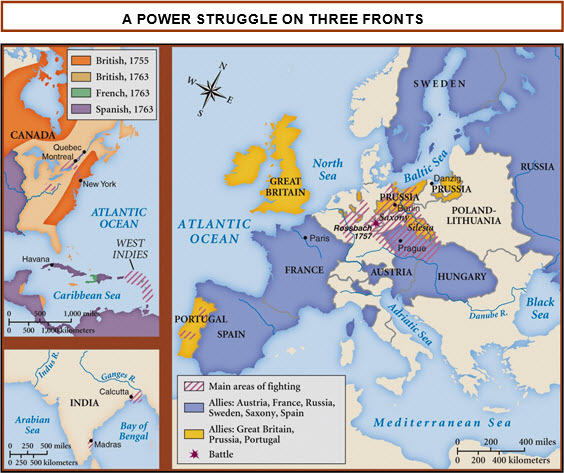 xxxxxAs we have seen, the War of the Austrian Succession, which broke out in 1740 and was concluded by the Treaty of Aix-La-Chapelle in 1748, really settled nothing. What it did do, in fact, was to provide the casus belli for the next conflict. Noxsooner was the war over than Maria Theresa of Austria was planning the re-conquest of Silesia, her wealthy province which had been seized and retained by Frederick II of Prussia. To achieve this end, she was quite prepared to accept a reversal of alliances (the so-called "Diplomatic Revolution" of 1756) whereby she allied with her traditional enemy, the French - even agreeing to the future marriage of her daughter Marie Antoinette to the future, ill-fated Louis XVI. On the other hand, Britain, her ally in the last conflict, because of a number of outstanding disputes with the French and the need to protect Hanover, switched its support to Prussia, whilst Russia, Sweden and Saxony, fearing the territorial ambitions of Frederick II, joined the Austrian camp.
xxxxxAs we have seen, the War of the Austrian Succession, which broke out in 1740 and was concluded by the Treaty of Aix-La-Chapelle in 1748, really settled nothing. What it did do, in fact, was to provide the casus belli for the next conflict. Noxsooner was the war over than Maria Theresa of Austria was planning the re-conquest of Silesia, her wealthy province which had been seized and retained by Frederick II of Prussia. To achieve this end, she was quite prepared to accept a reversal of alliances (the so-called "Diplomatic Revolution" of 1756) whereby she allied with her traditional enemy, the French - even agreeing to the future marriage of her daughter Marie Antoinette to the future, ill-fated Louis XVI. On the other hand, Britain, her ally in the last conflict, because of a number of outstanding disputes with the French and the need to protect Hanover, switched its support to Prussia, whilst Russia, Sweden and Saxony, fearing the territorial ambitions of Frederick II, joined the Austrian camp.
xxxxxThus the Seven Years War which began in 1756, a power struggle on three major fronts, was virtually a resumption of the disputes which had caused the War of the Austrian Succession. On the continent (see map above), it was a major conflagration between, on the one side, Prussia, supported by Great Britain and Hanover, and, on the other, Austria, assisted by France, Saxony, Russia and Sweden. Overseas, it developed into a battle between the two major colonial nations, France and Britain, conducted at sea and in the two principal areas of commercial rivalry, North America and India - the conflict in the New World coming to be known as the French and Indian War.
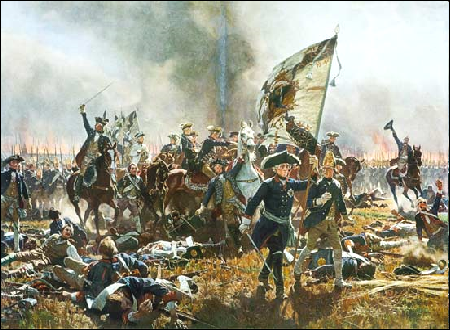 xxxxxFearing, with good cause, that Austria and Russia were about to attack him, Frederick II opened the war by invading Saxony and seizing Dresden. Then, the following year, he advanced into Bohemia. InxMay he defeated Charles of Lorraine at the Battle of Prague, but just a few weeks later he went down heavily to the Austrians at Kolin. Losing more than a third of his army, he was forced to retreat into Lusatia. Here, however, he made a remarkable recovery, and, towards the end of the year took on and defeated the French at Rossbach and the Austrians at Leuthen. He was heavily outnumbered in both these engagements, but his superior tactics won the day. Thenxin August 1758 he again invaded Bohemia, and won a victory over the Russians at the Battle of Zorndorf (illustrated here, leading the attack), but two months later was defeated by the Austrians at the Battle of Hochkirch and was lucky to make his escape.
xxxxxFearing, with good cause, that Austria and Russia were about to attack him, Frederick II opened the war by invading Saxony and seizing Dresden. Then, the following year, he advanced into Bohemia. InxMay he defeated Charles of Lorraine at the Battle of Prague, but just a few weeks later he went down heavily to the Austrians at Kolin. Losing more than a third of his army, he was forced to retreat into Lusatia. Here, however, he made a remarkable recovery, and, towards the end of the year took on and defeated the French at Rossbach and the Austrians at Leuthen. He was heavily outnumbered in both these engagements, but his superior tactics won the day. Thenxin August 1758 he again invaded Bohemia, and won a victory over the Russians at the Battle of Zorndorf (illustrated here, leading the attack), but two months later was defeated by the Austrians at the Battle of Hochkirch and was lucky to make his escape.
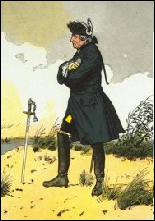 xxxxxThen, as we shall see, the year 1759 witnessed a serious down turn in Frederick's fortunes. He faced a powerful set of enemies, and his only ally, the British, had been forced to give up Hanover and Brunswick and dismiss their commander, the Duke of Cumberland. InxJuly the Russians won a resounding victory at Kay - the Prussians losing a quarter of their army - and then a combined Russian and Austrian force imposed a crushing defeat upon the Prussians at the Battle of Kunersdorf. Dresden was taken by Austria, and by now the whole of eastern Prussia was firmly in Russian hands. What appeared to be the decisive blow came in June 1760, when the Prussians suffered yet another defeat, this time at Landshut. Despite a surprise victory against an Austrian army at Leignitz, by October Russian and imperial forces were in Berlin.
xxxxxThen, as we shall see, the year 1759 witnessed a serious down turn in Frederick's fortunes. He faced a powerful set of enemies, and his only ally, the British, had been forced to give up Hanover and Brunswick and dismiss their commander, the Duke of Cumberland. InxJuly the Russians won a resounding victory at Kay - the Prussians losing a quarter of their army - and then a combined Russian and Austrian force imposed a crushing defeat upon the Prussians at the Battle of Kunersdorf. Dresden was taken by Austria, and by now the whole of eastern Prussia was firmly in Russian hands. What appeared to be the decisive blow came in June 1760, when the Prussians suffered yet another defeat, this time at Landshut. Despite a surprise victory against an Austrian army at Leignitz, by October Russian and imperial forces were in Berlin.
xxxxxFor Frederick the Great - pictured above after his defeat at Kunersdorf - all seemed lost. He was forced onto the defensive and feared the worst. In January 1762, however, the sudden death of the Empress of Russia, Elizabeth Petrovna, brought a welcome change in his fortunes. Her successor, Peter III, was a staunch admirer of Frederick. He lost no time in seeking a peace agreement, and the coalition against Prussia began to fall apart. The way was open for the Treaty of Paris in 1763 (G3a).
xxxxxBut in the meantime, far from the battlefields of northern Europe, Britain and France were engaged in what was to be the decisive battle for colonial mastery in North America and the sub-continent of India. From these contests Britain was to emerge as a nation of world significance.
Acknowledgements
Map (Europe/Canada/India): licensed under Creative Commons – historymaps.wikispaces.com. Zorndorf: by the German painter and illustrator Carl Roching (1855-1920), 1904. Frederick II: detail from The Battle of Kunersdorf , a coloured lithograph by the German artist Richard Knoetel (1857-1914) – private collection. Montcalm: by the French artist Antoine-François Sergent-Marceau (1751-1847), 1790 – Prints and Photographs Division, Library of Congress, Washington. Map (North America): licensed under Creative Commons – apushistorycase.wikispaces.com. Map (India): licensed under Creative Commons – www.ccis.edu/courses/HIST. Clive: detail, by the English painter Thomas Gainsborough, c1764 – National Army Museum, London. Dupleix: by the French printmaker Antoine Louis François Sergent-Marceau (1751-1847), 2nd half 18th century. Hawke: detail, by the English painter Francis Cotes (1726-1770), 1768/70 – National Maritime Museum, Greenwich, London. Byng: detail, by the English portrait painter Thomas Hudson (1701-1779), 1749 – private collection. Execution: c1760, artist unknown – Royal Museums, Greenwich, London. Map (India): licensed under Creative Commons – globehistorycullen.wikispaces.com.
G2-1727-1760-G2-1727-1760-G2-1727-1760-G2-1727-1760-G2-1727-1760-G2-1727-1760-G2
xxxxxWhile Frederick the Great fought hard to defend Prussia, the Anglo-French War in North America developed into a full-scale and decisive encounter. Here, rivalry between the British and the French had been a feature of colonial life long before the days of William III. Apart from constant border skirmishes, there had been three "official" conflicts, the last one being King George's War of 1740. This time, the fourth and final outbreak flared up in 1754, both sides determined to maintain their hold on their colonial lands, expand into the interior (notably the Ohio Valley) and, at the same time, keep and extend their lucrative trade in furs and fishing.
xxxxxAs far as the land struggle was concerned, the French had the strategic advantage. They held parts of the interior and, by means of a line of forts, were in a position to hem in the British colonies - strung out along a stretch of the Atlantic seaboard - thus preventing their spreading westward. Given that the British could be contained or, better still, removed, the French colonial power might well be extended from the St. Lawrence waterway in the north to New Orleans in the Deep South.
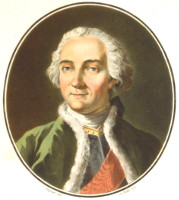 xxxxxAtxfirst, under their able commander the Marquis de Montcalm (1712-1759) (illustrated) the French were highly successful. In July 1754 they overran Fort Necessity - then commanded by the young Virginian George Washington - and a year later routed a British force under General Braddock as it approached Fort Duquesne, a recently-built stronghold guarding the entrance to the Ohio Valley. Then in 1756 Montcalm went on the offensive. He captured the British fort at Oswego on Lake Ontario, thereby tightening his grip on the Great Lakes, and the following year destroyed Fort William Henry, seriously restricting British advance to the north.
xxxxxAtxfirst, under their able commander the Marquis de Montcalm (1712-1759) (illustrated) the French were highly successful. In July 1754 they overran Fort Necessity - then commanded by the young Virginian George Washington - and a year later routed a British force under General Braddock as it approached Fort Duquesne, a recently-built stronghold guarding the entrance to the Ohio Valley. Then in 1756 Montcalm went on the offensive. He captured the British fort at Oswego on Lake Ontario, thereby tightening his grip on the Great Lakes, and the following year destroyed Fort William Henry, seriously restricting British advance to the north.
XXXXXXXXXXXXXXXXXXXXXXXXXXXXXXXXXXXXXX
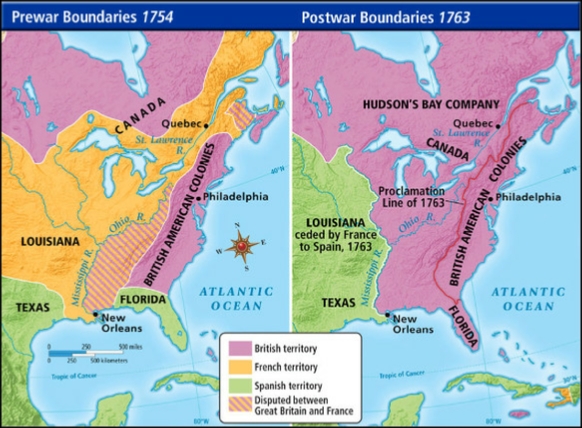 xxxxxBy 1758, however, the British command of the sea began to tell. Under the leadership of William Pitt the Elder, the British government had greatly increased aid to the colonies, and this turned the tide in their favour. The British and their Indian allies, reinforced and well led by Lord Amherst, now had the edge over the French. Despite a defeat at the Battle of Ticonderoga on the northern front, they advanced on Louisbourg, gaining its surrender, and, moving westward from Philadelphia, forced the French to abandon their important stronghold at Fort Duquesne - later named Pittsburg. As a result of these victories a number of native tribes began to desert the French cause. They were wise to do so. In 1759 the French cause was lost. A British expedition, moving inland, seized Niagara, whilst, in the north a force led by Amherst captured Ticonderoga and Crown Point, opening the way to Montreal. Meanwhile, as we shall see, an army under the command of General James Wolfe, having laid siege to Quebec, eventually managed to confront the enemy and defeat them at the Battle of Quebec, fought on the Plains of Abraham, just outside the city, in 1759. With the capture of Montreal the following year, attacked from three sides, French resistance was at an end, and New France (much of Canada) was in British hands.
xxxxxBy 1758, however, the British command of the sea began to tell. Under the leadership of William Pitt the Elder, the British government had greatly increased aid to the colonies, and this turned the tide in their favour. The British and their Indian allies, reinforced and well led by Lord Amherst, now had the edge over the French. Despite a defeat at the Battle of Ticonderoga on the northern front, they advanced on Louisbourg, gaining its surrender, and, moving westward from Philadelphia, forced the French to abandon their important stronghold at Fort Duquesne - later named Pittsburg. As a result of these victories a number of native tribes began to desert the French cause. They were wise to do so. In 1759 the French cause was lost. A British expedition, moving inland, seized Niagara, whilst, in the north a force led by Amherst captured Ticonderoga and Crown Point, opening the way to Montreal. Meanwhile, as we shall see, an army under the command of General James Wolfe, having laid siege to Quebec, eventually managed to confront the enemy and defeat them at the Battle of Quebec, fought on the Plains of Abraham, just outside the city, in 1759. With the capture of Montreal the following year, attacked from three sides, French resistance was at an end, and New France (much of Canada) was in British hands.
xxxxxThe Anglo-French War in North America was but a continuation of the long-term rivalry between the British and the French, both anxious to expand their colonial territories inland, and extend their trade in furs and fish. In the past, this had led to a series of wars, the last of which, the King George's War, had broken out in 1740. Strategically speaking, the French were well placed. Based inland, they held a string of forts which hemmed in the British colonies, stretched as they were along the Atlantic seaboard. Under their able commander, the Marquis de Montcalm, they repulsed attacks on Fort Duquesne, and then in 1756 captured the fort of Oswego, driving the British from the area around the Great Lakes. Then the following year they destroyed Fort William Henry, thus restricting British advance to the north. However, by 1758 the British command of the sea began to tell. Reinforced from Britain, the colonists were able to take the offensive. They captured Louisbourg, and then forced the French to abandon Fort Duquesne. The year 1759 saw the end of French power. Niagara was seized, together with Ticonderoga and Crown Point, and then, as we shall see, General James Wolfe won a decisive victory at the Battle of Quebec in 1759. With the capture of Montreal the following year, New France (much of Canada) was in the hands of the British.
xxxxxEuropean interest in India was awakened following the arrival there of the Portuguese explorer Vasco da Gama in 1498. The Dutch were the next to follow but, eventually, they settled in Indonesia so that, by the end of the 17th century, only the British and French had sizeable trading posts on the sub-continent. The British were based mainly at Madras, Bombay and Calcutta, the French at Pondicherry and Chandernagore. Fighting between the two sides had begun during the War of the Austrian Succession and, for a time, the French had occupied Madras. The French had an able leader in Dupleix, but they received very little support from their home government. In this the British had the advantage, but much of their success, in fact, was due to the leadership of the young soldier Robert Clive. He defeated the French at the Siege of Arcot in 1751, and then, as we shall see, won a resounding victory at the Battle of Plassey in 1757, gaining control of the wealthy province of Bengal. The end to French rule came with their defeat at the Battle of Wandiwash in 1760, and the fall of Pondicherry the following year. With the departure of the French, and the continued disintegration of the Mughal Empire, India was destined to fall under British control.
xxxxxAt the same time, the Anglo-French War in India brought further success for the British. Here, European involvement had begun at the very end of the 15th century with the arrival of the Portuguese navigator Vasco da Gama in 1498. They were followed by the Dutch, British and the French, but by the end of the 17th century only the British and French had sizeable trading posts on the sub-continent. The Portuguese held only a few outposts, including Goa on the western coast, and the Dutch had concentrated most of their efforts on gaining a monopoly of trade with Indonesia, the spice islands. By contrast, the British East India Company, founded in 1600 and backed by a powerful navy, had established trading forts (or "factories") at Madras, Bombay and Calcutta. ThexFrench were late in the field, but they had set up bases at a number of places, including those of Pondicherry and Chandernagore, and under the aggressive leadership of Governor Joseph-François Dupleix (1697-1763), had attempted to set up areas of direct or indirect rule in parts of southern India. Then, as we have seen, in 1746, during the War of the Austrian Succession, the troubled peace between the two sides came to an end and in the ensuing fighting Dupleix managed to seize Madras from the British.
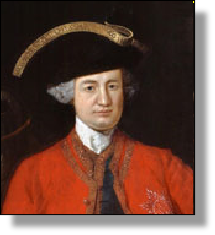
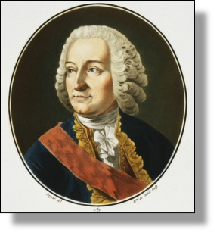 xxxxxThe fort at Madras was returned to the British by the Treaty of Aix-La-Chapelle in 1748, but the peace had been broken and there was no going back. In the fighting that followed, the French, less well established and receiving little support from their government at home, proved no match for the British. As we have seen, in 1751 they were defeated at the Siege of Arcot by a British force led by the military adventurer Robert Clive. Dupleix (illustrated right) was recalled home in 1754 and three years later, at the Battle of Plassey (1757), Clive (illustrated left) won a decisive victory over the Nawab of Bengal, the Indian ruler who, a year earlier, had taken Calcutta and been held responsible for the atrocity which came to be known as the Black Hole of Calcutta. The final collapse of French rule came in 1761. The English commander Sir Eyre Coote defeated them at the Battle of Wandiwash in 1760, and then captured their fort at Pondicherry the following year. With the French defeated, and the Mughal Empire disintegrating, the way was now open for British control of the sub-continent.
xxxxxThe fort at Madras was returned to the British by the Treaty of Aix-La-Chapelle in 1748, but the peace had been broken and there was no going back. In the fighting that followed, the French, less well established and receiving little support from their government at home, proved no match for the British. As we have seen, in 1751 they were defeated at the Siege of Arcot by a British force led by the military adventurer Robert Clive. Dupleix (illustrated right) was recalled home in 1754 and three years later, at the Battle of Plassey (1757), Clive (illustrated left) won a decisive victory over the Nawab of Bengal, the Indian ruler who, a year earlier, had taken Calcutta and been held responsible for the atrocity which came to be known as the Black Hole of Calcutta. The final collapse of French rule came in 1761. The English commander Sir Eyre Coote defeated them at the Battle of Wandiwash in 1760, and then captured their fort at Pondicherry the following year. With the French defeated, and the Mughal Empire disintegrating, the way was now open for British control of the sub-continent.
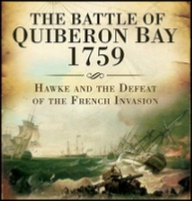
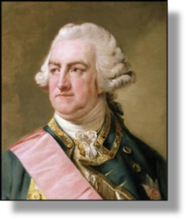 xxxxxThe success of the British in both North America and on the sub-continent of India was due in very large part to the strength and size of the British navy. This kept the seas open so that men and vital materials could be sent to assist the colonial forces. A number of victories ensured this free passage. In 1758, for example, Admiral Boscawen assisted Lord Amherst and General Wolfe in the capture of Louisbourg, Cape Breton, and the following year defeated a French fleet off Lagos in West Africa. InxNovember 1759 Admiral Edward Hawke (illustrated) won a brilliant victory over the French at the Battle of Quiberon Bay (off the coast of Brittany), destroying much of their fleet, and putting an end to their plan to invade Britain.
xxxxxThe success of the British in both North America and on the sub-continent of India was due in very large part to the strength and size of the British navy. This kept the seas open so that men and vital materials could be sent to assist the colonial forces. A number of victories ensured this free passage. In 1758, for example, Admiral Boscawen assisted Lord Amherst and General Wolfe in the capture of Louisbourg, Cape Breton, and the following year defeated a French fleet off Lagos in West Africa. InxNovember 1759 Admiral Edward Hawke (illustrated) won a brilliant victory over the French at the Battle of Quiberon Bay (off the coast of Brittany), destroying much of their fleet, and putting an end to their plan to invade Britain.

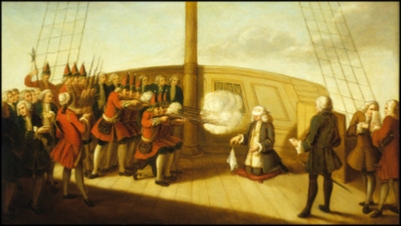 xxxxxButxthe war at sea was not without at least one costly failure. On the eve of the war, Admiral John Byng (1704-1757) had been sent to the Mediterranean to defend the island of Minorca. On arrival he found that a French force had already landed on the island and, after engaging a powerful French fleet for best part of a day, returned to Gibraltar, convinced that his force was too weak to take on the enemy (as it probably was). However, on his return to England he was found guilty of "neglect of duty" and shot by firing squad on the deck of his own flagship in Portsmouth harbour! His life could have been spared by a royal pardon. The fact that it wasn't suggests that Byng was used as a scapegoat to cover up the government's poor war record up to that time. But whatever the rights and wrongs of the matter, it might be said that this action inculcated in future naval commanders “a culture of aggressive determination” which was not always apparent in their enemy counterparts. As the French writer Voltaire remarked in his satire Candide in 1759, the British executed an admiral from time to time “to encourage the others”!
xxxxxButxthe war at sea was not without at least one costly failure. On the eve of the war, Admiral John Byng (1704-1757) had been sent to the Mediterranean to defend the island of Minorca. On arrival he found that a French force had already landed on the island and, after engaging a powerful French fleet for best part of a day, returned to Gibraltar, convinced that his force was too weak to take on the enemy (as it probably was). However, on his return to England he was found guilty of "neglect of duty" and shot by firing squad on the deck of his own flagship in Portsmouth harbour! His life could have been spared by a royal pardon. The fact that it wasn't suggests that Byng was used as a scapegoat to cover up the government's poor war record up to that time. But whatever the rights and wrongs of the matter, it might be said that this action inculcated in future naval commanders “a culture of aggressive determination” which was not always apparent in their enemy counterparts. As the French writer Voltaire remarked in his satire Candide in 1759, the British executed an admiral from time to time “to encourage the others”!
xxxxxAs we shall see, the Seven Years War was brought to an end by the Treaty of Paris in 1763 (G3a). Britain emerged as the world's greatest colonial power and Prussia - despite earlier fears - as one of Europe's dominant nations. Both results were to have lasting consequences for Europe and the world at large.
X
xxxxxIncidentally, the Anglo-Fren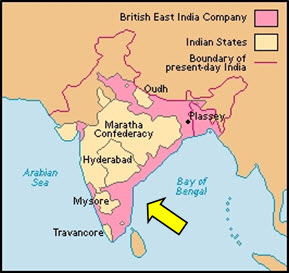 ch wars in India at this time are often referred to as the Carnatic Wars, so called because, for the most part, they took place in the Carnatic Region (arrowed on map), a strip of land along the east coast of southern India. As we have seen, the First Carnatic War (1746-1748) - an offshoot of the War of the Austrian Succession - highlighted British failure. The French, led by their governor-general Joseph François Dupleix, captured Madras in 1746 and successfully repulsed a number of attacks upon Pondicherry, their administrative centre. The Second unofficial conflict covered the years 1751-1754. This included Clive's victory at Arcot, and culminated in the recall of Dupleix to France. The Third and final confrontation, conducted during the war under discussion, saw an end to French hopes for an Indian empire following the British victories at Plassey and Wandiwash, and the fall of Pondicherry in 1761.
ch wars in India at this time are often referred to as the Carnatic Wars, so called because, for the most part, they took place in the Carnatic Region (arrowed on map), a strip of land along the east coast of southern India. As we have seen, the First Carnatic War (1746-1748) - an offshoot of the War of the Austrian Succession - highlighted British failure. The French, led by their governor-general Joseph François Dupleix, captured Madras in 1746 and successfully repulsed a number of attacks upon Pondicherry, their administrative centre. The Second unofficial conflict covered the years 1751-1754. This included Clive's victory at Arcot, and culminated in the recall of Dupleix to France. The Third and final confrontation, conducted during the war under discussion, saw an end to French hopes for an Indian empire following the British victories at Plassey and Wandiwash, and the fall of Pondicherry in 1761.






 xxxxxAs we have seen, the War of the Austrian Succession, which broke out in 1740 and was concluded by the Treaty of Aix-
xxxxxAs we have seen, the War of the Austrian Succession, which broke out in 1740 and was concluded by the Treaty of Aix- xxxxxFearing, with good cause, that Austria and Russia were about to attack him, Frederick II opened the war by invading Saxony and seizing Dresden. Then, the following year, he advanced into Bohemia. InxMay he defeated Charles of Lorraine at the Battle of Prague, but just a few weeks later he went down heavily to the Austrians at Kolin. Losing more than a third of his army, he was forced to retreat into Lusatia. Here, however, he made a remarkable recovery, and, towards the end of the year took on and defeated the French at Rossbach and the Austrians at Leuthen. He was heavily outnumbered in both these engagements, but his superior tactics won the day. Thenxin August 1758 he again invaded Bohemia, and won a victory over the Russians at the Battle of Zorndorf (illustrated here, leading the attack), but two months later was defeated by the Austrians at the Battle of Hochkirch and was lucky to make his escape.
xxxxxFearing, with good cause, that Austria and Russia were about to attack him, Frederick II opened the war by invading Saxony and seizing Dresden. Then, the following year, he advanced into Bohemia. InxMay he defeated Charles of Lorraine at the Battle of Prague, but just a few weeks later he went down heavily to the Austrians at Kolin. Losing more than a third of his army, he was forced to retreat into Lusatia. Here, however, he made a remarkable recovery, and, towards the end of the year took on and defeated the French at Rossbach and the Austrians at Leuthen. He was heavily outnumbered in both these engagements, but his superior tactics won the day. Thenxin August 1758 he again invaded Bohemia, and won a victory over the Russians at the Battle of Zorndorf (illustrated here, leading the attack), but two months later was defeated by the Austrians at the Battle of Hochkirch and was lucky to make his escape.  xxxxxThen, as we shall see, the year 1759 witnessed a serious down turn in Frederick's fortunes. He faced a powerful set of enemies, and his only ally, the British, had been forced to give up Hanover and Brunswick and dismiss their commander, the Duke of Cumberland. InxJuly the Russians won a resounding victory at Kay -
xxxxxThen, as we shall see, the year 1759 witnessed a serious down turn in Frederick's fortunes. He faced a powerful set of enemies, and his only ally, the British, had been forced to give up Hanover and Brunswick and dismiss their commander, the Duke of Cumberland. InxJuly the Russians won a resounding victory at Kay - xxxxxAtxfirst, under their able commander the Marquis de Montcalm (1712-
xxxxxAtxfirst, under their able commander the Marquis de Montcalm (1712- xxxxxBy 1758, however, the British command of the sea began to tell. Under the leadership of William Pitt the Elder, the British government had greatly increased aid to the colonies, and this turned the tide in their favour. The British and their Indian allies, reinforced and well led by Lord Amherst, now had the edge over the French. Despite a defeat at the Battle of Ticonderoga on the northern front, they advanced on Louisbourg, gaining its surrender, and, moving westward from Philadelphia, forced the French to abandon their important stronghold at Fort Duquesne -
xxxxxBy 1758, however, the British command of the sea began to tell. Under the leadership of William Pitt the Elder, the British government had greatly increased aid to the colonies, and this turned the tide in their favour. The British and their Indian allies, reinforced and well led by Lord Amherst, now had the edge over the French. Despite a defeat at the Battle of Ticonderoga on the northern front, they advanced on Louisbourg, gaining its surrender, and, moving westward from Philadelphia, forced the French to abandon their important stronghold at Fort Duquesne -
 xxxxxThe fort at Madras was returned to the British by the Treaty of Aix-
xxxxxThe fort at Madras was returned to the British by the Treaty of Aix-
 xxxxxThe success of the British in both North America and on the sub-
xxxxxThe success of the British in both North America and on the sub-
 xxxxxButxthe war at sea was not without at least one costly failure. On the eve of the war, Admiral John Byng (1704-
xxxxxButxthe war at sea was not without at least one costly failure. On the eve of the war, Admiral John Byng (1704- ch wars in India at this time are often referred to as the
ch wars in India at this time are often referred to as the 

